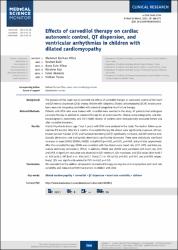| dc.contributor.author | Oflaz, Mehmet Burhan | |
| dc.contributor.author | Ballı, Şevket | |
| dc.contributor.author | Kibar, Ayşe Esin | |
| dc.contributor.author | Ece, İbrahim | |
| dc.contributor.author | Akdeniz, Celal | |
| dc.contributor.author | Tuzcu, Volkan | |
| dc.date.accessioned | 10.07.201910:49:13 | |
| dc.date.accessioned | 2019-07-10T19:35:53Z | |
| dc.date.available | 10.07.201910:49:14 | |
| dc.date.available | 2019-07-10T19:35:53Z | |
| dc.date.issued | 2013 | en_US |
| dc.identifier.citation | Oflaz, M. B., Ballı, Ş., Kibar, A. E., Ece, İ., Akdeniz, C. ve Tuzcu, V. (2013). Effects of carvedilol therapy on cardiac autonomic control, QT dispersion, and ventricular arrhythmias in children with dilated cardiomyopathy. Medical Science Monitor, 19(1), 366-372. https://dx.doi.org/10.12659/MSM.883911 | en_US |
| dc.identifier.issn | 1234-1010 | |
| dc.identifier.uri | https://hdl.handle.net/20.500.12511/979 | |
| dc.identifier.uri | https://dx.doi.org/10.12659/MSM.883911 | |
| dc.description.abstract | The purpose of this study was to examine the effects of carvedilol therapy on autonomic control of the heart and QT-interval dispersion (QTd) among children with idiopathic dilated cardiomyopathy (DCM) whose symptoms were not adequately controlled with standard congestive heart failure therapy. Material/Methods: Patients with DCM who were treated with carvedilol were enrolled in the study. All patients had undergone carvedilol therapy in addition to standard therapy for at least 6 months. Clinical, echocardiographic, and electrocardiographic parameters, and 24-h Holter records of patients were retrospectively evaluated before and after carvedilol treatment. Results: A total 34 patients (mean age: 7.4±4.3 years) with DCM were analyzed in the study. The median follow-up period was 9.5 months. After the 6 months of carvedilol therapy the clinical score significantly improved, left ventricular ejection fraction (LVEF) and fractional shortening (LVFS) significantly increased, and left ventricle enddiastolic dimensions and end-systolic dimensions significantly decreased. There were statistically significant increases in mean SDNN, SDANN, rMSSD, and pNN50 (p=0.002, p=0.001, p=0.008, and p=0.026, respectively). After the carvedilol therapy, SDNN was correlated with the clinical score, heart rate, LVEF, LVFS, and total premature ventricular contractions (PVCs). In addition, rMSSD and pNN50 were correlated with heart rate, LVEF and LVFS. A significant reduction was observed in QTc-minimum, QTc-maximum, and QTd values (434.9±40.7 vs. 416.1±36.5, 497.8±43.6 vs. 456.3±41.7, 58.6±17.1 vs. 49.3±15.6; p<0.001, p=0.001, and p=0.008, respectively). QTd was significantly related to PVCs (r=0.62, p=0.02). Conclusions: We conclude that the addition of carvedilol to standard therapy can improve clinical symptoms and heart rate variability, and reduce in arrhythmia markers in children with DCM. | en_US |
| dc.language.iso | eng | en_US |
| dc.rights | info:eu-repo/semantics/openAccess | en_US |
| dc.subject | Carvedilol | en_US |
| dc.subject | Children | en_US |
| dc.subject | Dilated Cardiomyopathy | en_US |
| dc.subject | Heart Rate Variability | en_US |
| dc.subject | QT Dispersion | en_US |
| dc.title | Effects of carvedilol therapy on cardiac autonomic control, QT dispersion, and ventricular arrhythmias in children with dilated cardiomyopathy | en_US |
| dc.type | article | en_US |
| dc.relation.ispartof | Medical Science Monitor | en_US |
| dc.department | İstanbul Medipol Üniversitesi, Tıp Fakültesi, Dahili Tıp Bilimleri Bölümü, Çocuk Sağlığı ve Hastalıkları Ana Bilim Dalı | en_US |
| dc.authorid | 0000-0002-8647-6055 | en_US |
| dc.authorid | 0000-0001-9008-4997 | en_US |
| dc.identifier.volume | 19 | en_US |
| dc.identifier.issue | 1 | en_US |
| dc.identifier.startpage | 366 | en_US |
| dc.identifier.endpage | 372 | en_US |
| dc.relation.publicationcategory | Makale - Uluslararası Hakemli Dergi - Kurum Öğretim Elemanı | en_US |
| dc.identifier.doi | 10.12659/MSM.883911 | en_US |
| dc.identifier.wosquality | Q3 | en_US |
| dc.identifier.scopusquality | Q2 | en_US |


















